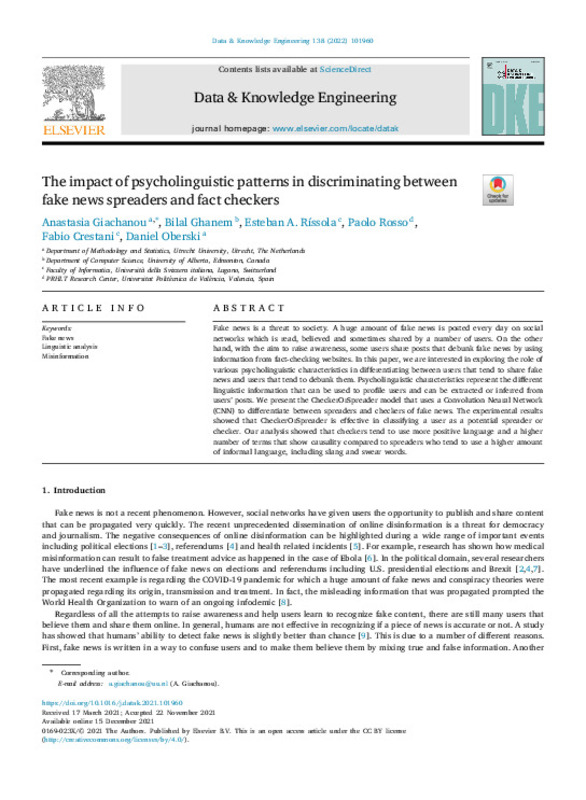JavaScript is disabled for your browser. Some features of this site may not work without it.
Buscar en RiuNet
Listar
Mi cuenta
Estadísticas
Ayuda RiuNet
Admin. UPV
The Impact of Psycholinguistic Patterns in Discriminating between Fake News Spreaders and Fact Checkers
Mostrar el registro sencillo del ítem
Ficheros en el ítem
| dc.contributor.author | Giachanou, Anastasia
|
es_ES |
| dc.contributor.author | Ghanem, Bilal Hisham Hasan
|
es_ES |
| dc.contributor.author | Rissola, Esteban A.
|
es_ES |
| dc.contributor.author | Rosso, Paolo
|
es_ES |
| dc.contributor.author | Crestani, Fabio
|
es_ES |
| dc.contributor.author | Oberski, Daniel
|
es_ES |
| dc.date.accessioned | 2023-09-18T18:02:06Z | |
| dc.date.available | 2023-09-18T18:02:06Z | |
| dc.date.issued | 2022-03-31 | es_ES |
| dc.identifier.issn | 0169-023X | es_ES |
| dc.identifier.uri | http://hdl.handle.net/10251/196716 | |
| dc.description.abstract | [EN] Fake news is a threat to society. A huge amount of fake news is posted every day on social networks which is read, believed and sometimes shared by a number of users. On the other hand, with the aim to raise awareness, some users share posts that debunk fake news by using information from fact-checking websites. In this paper, we are interested in exploring the role of various psycholinguistic characteristics in differentiating between users that tend to share fake news and users that tend to debunk them. Psycholinguistic characteristics represent the different linguistic information that can be used to profile users and can be extracted or inferred from users¿ posts. We present the CheckerOrSpreader model that uses a Convolution Neural Network (CNN) to differentiate between spreaders and checkers of fake news. The experimental results showed that CheckerOrSpreader is effective in classifying a user as a potential spreader or checker. Our analysis showed that checkers tend to use more positive language and a higher number of terms that show causality compared to spreaders who tend to use a higher amount of informal language, including slang and swear words. | es_ES |
| dc.description.sponsorship | The works of Anastasia Giachanou and Daniel Oberski were funded by the Dutch Research Council (grant VI.Vidi.195.152). The work of Paolo Rosso was in the framework of the XAI-DisInfodemics project on eXplainable AI for disinformation and conspiracy detection during infodemics (PLEC2021-007681), funded by the Spanish Ministry of Science and Innovation, as well as IBERIFIER, the Iberian Digital Media Research and Fact-Checking Hub funded by the European Digital Media Observatory (2020-EU-IA0252). | es_ES |
| dc.language | Inglés | es_ES |
| dc.publisher | Elsevier | es_ES |
| dc.relation.ispartof | Data & Knowledge Engineering | es_ES |
| dc.rights | Reconocimiento (by) | es_ES |
| dc.subject | Fake news | es_ES |
| dc.subject | Linguistic analysis | es_ES |
| dc.subject | Misinformation | es_ES |
| dc.subject.classification | LENGUAJES Y SISTEMAS INFORMATICOS | es_ES |
| dc.title | The Impact of Psycholinguistic Patterns in Discriminating between Fake News Spreaders and Fact Checkers | es_ES |
| dc.type | Artículo | es_ES |
| dc.identifier.doi | 10.1016/j.datak.2021.101960 | es_ES |
| dc.relation.projectID | info:eu-repo/grantAgreement/AEI/Plan Estatal de Investigación Científica y Técnica y de Innovación 2017-2020/PLEC2021-007681/ES/IA explicable para desinformación y detección de conspiración durante infodemias (XAI-DisInfodemics)/ | es_ES |
| dc.relation.projectID | info:eu-repo/grantAgreement/INEA//INEA%2FCEF%2FICT%2FA2020%2F2381931/EU/Iberian Digital Media Research and Fact-Checking Hub/IBERIFIER | es_ES |
| dc.relation.projectID | info:eu-repo/grantAgreement/EC//2020-EU-IA-0252/EU/Iberian Digital Media Research and Fact-Checking Hub/IBERIFIER/ | es_ES |
| dc.rights.accessRights | Abierto | es_ES |
| dc.contributor.affiliation | Universitat Politècnica de València. Escola Tècnica Superior d'Enginyeria Informàtica | es_ES |
| dc.description.bibliographicCitation | Giachanou, A.; Ghanem, BHH.; Rissola, EA.; Rosso, P.; Crestani, F.; Oberski, D. (2022). The Impact of Psycholinguistic Patterns in Discriminating between Fake News Spreaders and Fact Checkers. Data & Knowledge Engineering. 138:1-15. https://doi.org/10.1016/j.datak.2021.101960 | es_ES |
| dc.description.accrualMethod | S | es_ES |
| dc.relation.publisherversion | https://doi.org/10.1016/j.datak.2021.101960 | es_ES |
| dc.description.upvformatpinicio | 1 | es_ES |
| dc.description.upvformatpfin | 15 | es_ES |
| dc.type.version | info:eu-repo/semantics/publishedVersion | es_ES |
| dc.description.volume | 138 | es_ES |
| dc.relation.pasarela | S\488736 | es_ES |
| dc.contributor.funder | European Commission | es_ES |
| dc.contributor.funder | UNIVERSIDAD DE NAVARRA | es_ES |
| dc.contributor.funder | AGENCIA ESTATAL DE INVESTIGACION | es_ES |
| dc.contributor.funder | Netherlands Organization for Scientific Research | es_ES |








